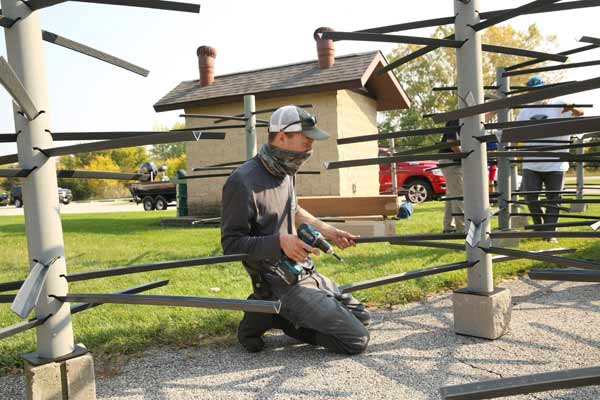
ELTON – Anglers have more spots to search for the perfect catch at Belton Lake thanks to some recently installed artificial reefs and habitat structures. The Texas Parks and Wildlife Department (TPWD) Waco and Forth Worth Inland Fisheries Districts partnered with multiple organizations and volunteers to complete the project which will significantly enhance the fishery.
“We were very excited when the opportunity arose to partner with Texas B.A.S.S. Nation and our local bass clubs to enhance the fishery at Lake Belton,” said John Tibbs, Inland Fisheries Waco District Supervisor. “Thanks to support from our partners, this project became a reality and anglers will benefit from these improvements for many years to come.”
The design of the project called for four large artificial reefs and was one of the largest collaborative projects the Waco Inland Fisheries District has done to date. Numerous partners and contributors supported TPWD to make this initiative possible. Texas B.A.S.S Nation, Tincup Whiskey, Texas Anglers Bass Club and Centex Bass Hunters volunteers, Baylor University student volunteers, Brazos River Authority, U.S. Army Corp of Engineers, Mossback Fish Habitat, and Quality Brick Works.
Artificial reefs provide cover for bass, catfish, crappie and other species. Belton Lake is a popular spot for anglers in Central Texas and this project is part of an overall plan to improve the fishery. Most of the shoreline provides very steep, rocky fish habitat. Majestic tall bluffs and long rocky points are most common, although sand and mud flats can be found up the Leon River and Cowhouse Creek arms. The lake has little aquatic vegetation and timber is limited in many areas, so these new reefs are a welcome addition.
Texas B.A.S.S. Nation Conservation Director Dave Terre, who recently retired from TPWD after 35 years of service, said they were blessed with a grant from Tincup Whiskey and reached out to TPWD to support this project.
“When this grant came in, my first thought was to do a habitat project on a reservoir that needed it,” said Terre. “We met as an organization and decided that Belton Lake was a place where we would love to do a project like this. The first phone call I made was to John Tibbs, TPWD Inland Fisheries Waco District supervisor. I worked with John for many years at TPWD and knew he would be excited to partner with us on this project. The Brazos River Authority had also reached out to John with some funds to partner on this type of a project and it all came together for Belton Lake.”
Texas B.A.S.S. Nation is made up of affiliated bass clubs across the state in multiple regions and Belton Lake falls into the Northcentral Region. The organization worked with several of its clubs to select habitat deployment sites and provide the labor, in partnership with TPWD on this project.
“I think what this project shows is a way that anglers can partner with a state agency and private business to improve habitat for fish and make fishing better for anglers,” added Terre. “This project is a shining example, and we hope to continue helping with more of these type initiatives into the future. We can be so much more effective on restoring degrading fish habitats in our reservoirs if we work together in partnership with the state’s anglers to get the work done.”
TPWD constructed and placed Georgia cubes which are a 4’x4’x4’ frame of 1 ½” schedule 40 pvc with 100’ of flexible black perforated pvc drainage pipe contained within. The project team also assembled and placed 60 Mossback “Trophy Trees,” 24 Mossback “Safe Havens,” and 2 Mossback “Conservation Cubes.” A total of four fish reefs were created, three of which consisted of six Georgia cubes, 15 Trophy Trees, and six Safe Havens. The other reef was made up of five Georgia cubes, 15 Trophy Trees, six Safe Havens, and two conservation Cubes.
With the new structures in place, TPWD biologists followed up to see the early results. The evaluation used sonar and discovered that fish were using the structures less than two weeks after installation.
Coordinates for these new spots are:
Reef 1: N 31.14600, W -97.51780
Reef 2: N 31.14142, W -97.50919
Reef 3: N 31.14196, W -97.50539
Reef 4: N 31.14517, W -97.48168
These new habitat structures along with existing structures on other lakes are publicly available online. Anglers can punch these coordinates into their GPS or download the coordinates for use in GPS devices.
